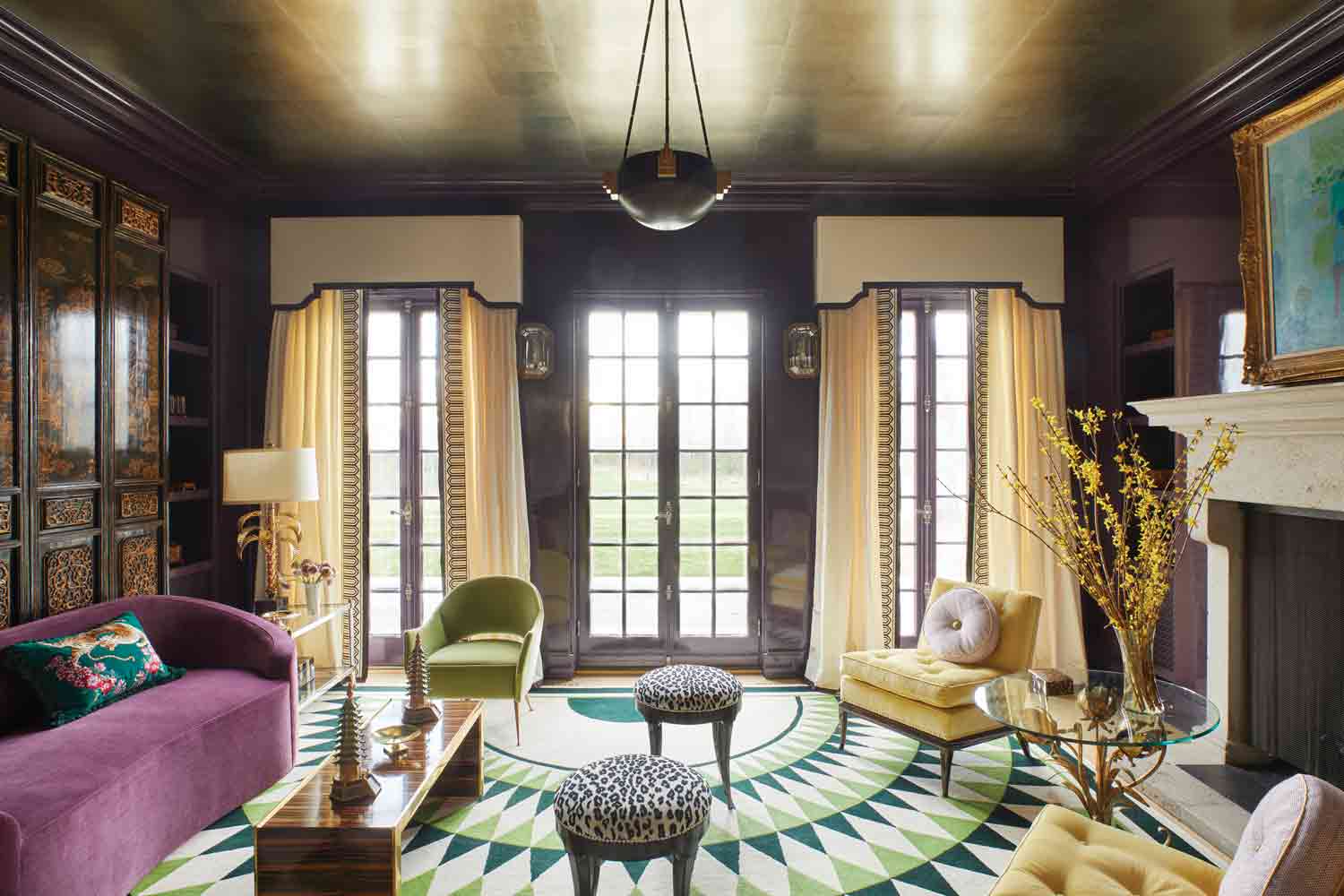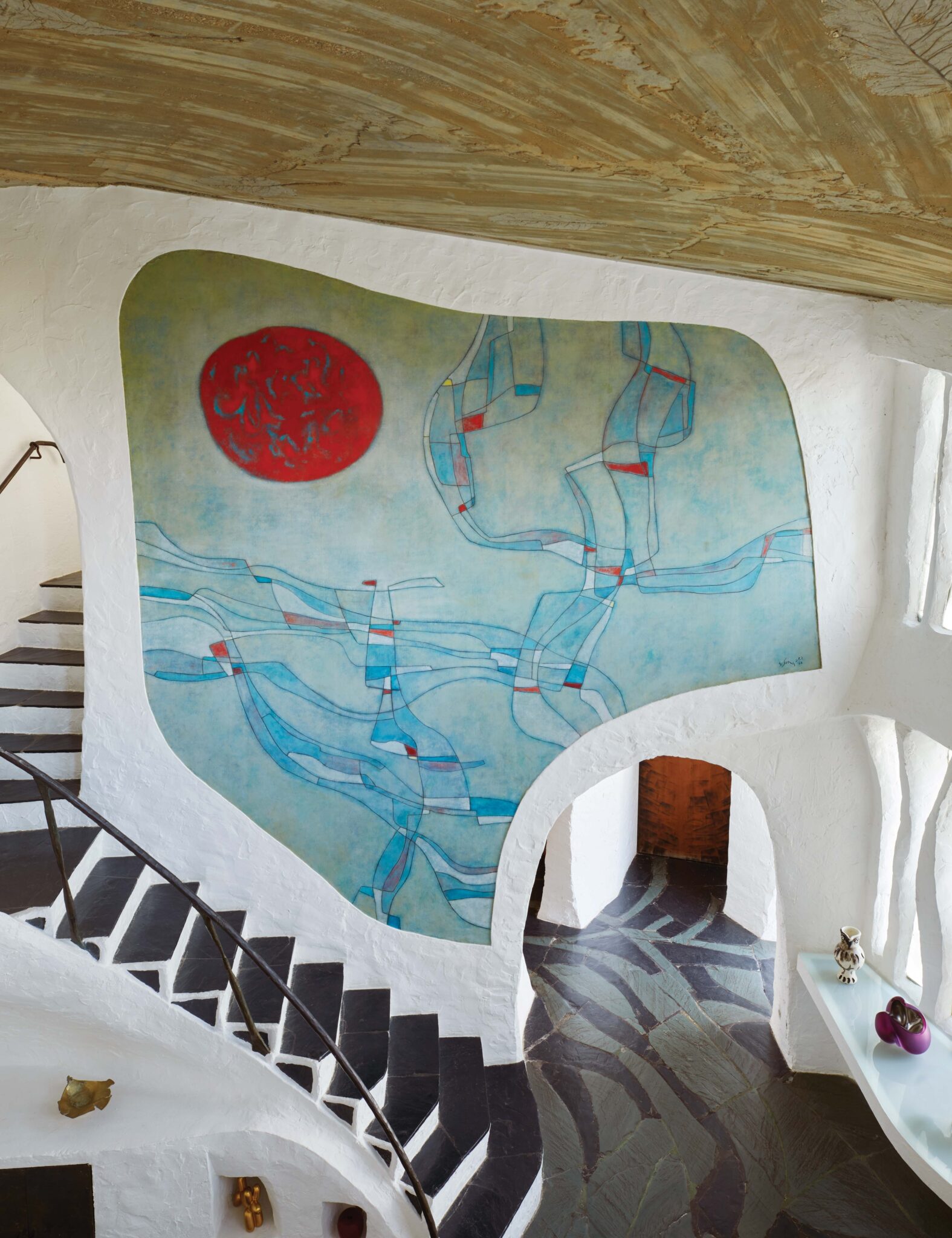When Ruthie Sommers agreed to take on the revamp of her longtime clients’ new home in Lake Bluff, Illinois, she knew she’d have big—practically diamond-encrusted—shoes to fill: The last designers to cast their aesthetic pixie dust over the 10,000-square-foot residence were legends Billy Baldwin and Frances Elkins. “The dining room was on the cover of House & Garden in 1932,” says Sommers, who has offices in Los Angeles, Aspen and Newport. “There was a little bit of peer pressure when I saw the Lucite banisters!”

Baldwin and Elkins’s efforts had been undone by “some unfortunate ’80s work” in the intervening decades, says the owner, and by the time she and her husband bought the home, “it was very gloomy and dark—everything was brown and faux renaissance.” Having teamed up with Sommers on two previous projects, including a color-drenched Chicago townhouse intended to provide a cheerful new start as the wife battled (and eventually beat) cancer, they knew that Sommers would have the effervescent, upbeat vision necessary to bring the 1930s structure back to life. The feeling was mutual: “They were A+ clients—never a question about ‘was that too many yards?’ Or ‘are you sure we like that?’ Or ‘can you do better?’ ” says Sommers. “It almost makes the job harder, because when they have so much trust in you, you just want to make sure you do right by them!”

Ruthie Sommers wrapped the entire sunroom of this 1930s Lake Bluff, Illinois, estate in a pale celery-green patterned linen by Pintura Studio— including walls, curtains, a long, languid sofa, and shell-shaped Venus chairs from Soane.
Francesco Lagnese-

In the dining room, pink sheers and an antique chandelier from David Duncan supply instant glamour. Ditto the portrait. “That’s a fake Rembrandt,” Sommers says. “It’s sort of an inside joke.” Keno rug by Patterson Flynn Martin.
Francesco Lagnese -

The architects installed arched doorways that add a cinematic touch to the main living spaces.
Francesco Lagnese
Working alongside architect Austin Depree of Northworks in Chicago, Sommers began planning an age-appropriate facelift, infusing each room with a fresh, energetic personality worthy of the Instagram era, but still in keeping with the home’s storied bones. The original intention had been to “let the architecture speak for itself and do everything in neutrals,” explains Sommers, but color crept back in as the process went on. “We just couldn’t help ourselves—we ended up with an eggplant lacquered room!” she laughs. The ultimate goal: a “boho-preppy, faded-World of Interiors” retreat.
Making the process easier was the fact that the team took their time to revamp the Mediterranean-style property, which was originally designed by architect Russell Walcott and sits proudly on 10 acres. “There was a lot of integrity in finishing the job properly,” says Sommers. “What was important was picking things that worked for the house, even if that involved waiting a while when we needed to. If we couldn’t figure out a curtain style, we didn’t rush it.” To that end, she and her clients spent more than four years sourcing items from across the globe. “We’ve shopped in Palm Beach, in New York and at auctions in Europe. It’s so hard to even try to remember where we bought everything—it’s almost like we were two old ladies traveling around, just buying something here and there!”

The homeowners’ “Drinks Room” is a favorite at cocktail hour. “It was supposed to be just silver and purple, but we just kept getting more colorful and more colorful and we couldn’t stop,” Sommers says. The lacquered metallic ceiling supplies an ethereal effect overhead, juxtaposed by a graphic sunburst rug, which the designer had custom made by
Patterson Flynn Martin.
-

A Gabriella Crespi mirror echoes the foyer’s opulently curved ceiling.
Francesco Lagnese -

The custom plaster mural of lotus leaves by Patrick Roullier in a powder room
Francesco Lagnese
feels original to the home.
Also freeing: Sommers didn’t hem herself in to one particular look. “The house really evolved; I don’t think there is a style,” she says. “I think that as you get older, people either hold on to one thing very tightly or just kind of let it go, which is what we did.” The resulting spaces are eye candy without any hackneyed tropes, ranging from a sunroom sheathed in pale celery-green linen to a drinks room with a silver lacquered ceiling. In the wife’s office, Sommers fashioned a true lady’s lair, furnishing it with a French Art Deco sofa from Carole Decombe Galerie, reupholstered in bubblegum-pink velvet, and a light-as-air Lucite desk that puts the focus on verdant wallcoverings. To bring the main living spaces back down to earth, Sommers relied on jute rugs underfoot. “We were trying to evoke the grand halls of English countryside houses with all those old Indian rush rugs,” she notes.
Sommers also riffed on themes from other design greats throughout the decades. “Everything kind of came from different tear sheets and inspiration pages,” she explains. The guest room pelmets were inspired by David Hicks; lime-green pleated silk trim on the office curtains were pulled from a space designed by Miles Redd; a custom sofa in the living room was based on a Vladimir Kagan original. There are callbacks to the house’s original designers, too. After seeing an image of a closet that Elkins had designed for a Chicago residence in 1929, with cerused-wood walls and inlaid mirror, Sommers decided to recreate it for the wife. “She loves clothes and shoes and had worked in fashion, so we wanted to give her a fabulous closet, but didn’t want it to feel tacky. We decided to basically copy Frances’s exact closet—the idea was to just make it feel like it had been there the whole time.”
-

The breakfast room was kept intentionally neutral to “really make sure the main event is the exterior.” Dining table by Luca.
Francesco Lagnese -

A custom Vladimir Kagan–inspired sofa takes pride of place in the outsized living room alongside buxom footstools sourced on a Chicago shopping spree. “We rearranged the living room so many times—it’s a really big space, so it was hard to deal with—but we ended up happy with the way that we have it,” says Sommers. Keno rug, Patterson Flynn Martin.
Francesco Lagnese

Schumacher’s Gainsborough Velvet in the perfect bubblegum pink bedecks an antique Parisian sofa in the wife’s home office. Sommers used a graphic rug to ground the space and set off the flourishing flora on the walls. Pleated silk-trimmed curtains (in Botticelli Silk Taffeta by Schumacher) were an idea borrowed from her friend Miles Redd.
Francesco LagneseJust as bling is imperative on the red carpet, a smattering of megawatt lighting fixtures were key in setting an appropriately glam tone in each space. “The longer we waited, the more we saw new lighting that we liked,” Sommers recalls. “We had a Georgian chandelier from a David Adler house in Chicago, pendants from the Metropolitan Museum of Art that we bought through David Duncan in New York, pieces from 1930s speakeasies.” The mix was intentional: Early on, Sommers and her clients made the decision to use only pieces that felt special, whether they “went together” or not. “I don’t know how to say this without sounding glib,” says Sommers, “but I’ve done three houses for this client, and for this house, we really did not care. We did care, but we just wanted to buy pieces that we loved and we weren’t really attached to the outcome!” No doubt Billy and Frances would approve.

A canopy bed that Sommers found in New Orleans adds flouncy fun in a guest room lined in silk wallpaper.
Francesco Lagnese
In the main closet, the team copied a Frances Elkins cerused-wood treatment and accented it with inlaid mirrors; custom rug by Patterson Flynn Martin.
Francesco Lagnese
















